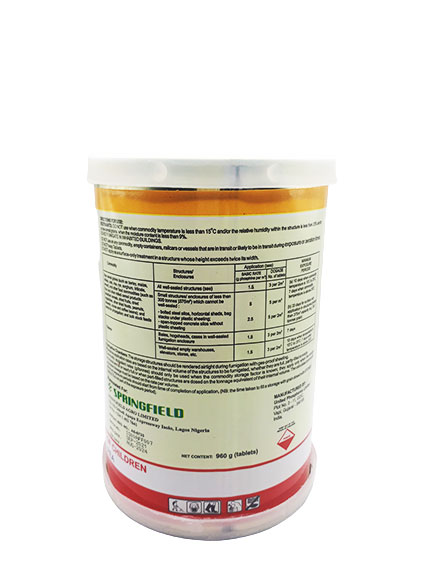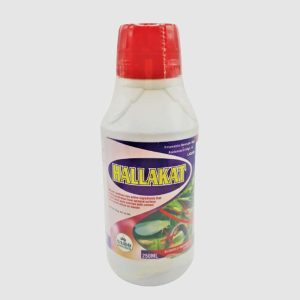STOREX PHOSPHIDE
₦27,200.00
STOREX is used for the control of insect and rodent pests in grains (wheat, rye, barley, rice, sorghum, maize, etc), seed grains, grain products (flour, noodles, semolina, etc) pulses (peas, beans, lentils, etc), tobacco, tapioca, (roots and flour), oil seeds, expeller cake, nuts, nuts kernels, dried fruits, coffee beans, cocoa beans, tea, etc, and in empty warehouses, silos, packing materials, transport containers, etc.
FIELDS OF APPLICATION:
STOREX is used for the control of insect and rodent pests in grains (wheat, rye, barley, rice, sorghum, maize, etc), seed grains, grain products (flour, noodles, semolina, etc) pulses (peas, beans, lentils, etc), tobacco, tapioca, (roots and flour), oil seeds, expeller cake, nuts, nuts kernels, dried fruits, coffee beans, cocoa beans, tea, etc, and in empty warehouses, silos, packing materials, transport containers, etc.
WARNING:
In moist air, STOREX releases poisonous gas. Storex tablets are to be used only by experienced adult personnel familiar with the precautionary measures and well-instructed on its use. Do not open containers except for immediate usage. Protect from open flames, heat, or moisture. Avoid breathing of gas or dust arising from treatment. Poisonous if swallowed. Keep available a gas mask with a respirator with a proper filter against Phosphine for an emergency. Wear protective clothing and a respirator while entering fumigated area. Fumigation must never take place in inhabited buildings. Wash hands thoroughly. Protect by sealing or otherwise, sensitive electronic equipment containing copper/copper alloy components.
FIRST AID:
Symptoms of Phosphine poisoning include pressing sensations in the chest, nausea, and diarrhoea. Affected persons should be immediately taken into the open air, laid down in a comfortable position, and kept quiet and warm. In case of slight poisoning, patient will recover rapidly in 1-2 hours. However, he should not resume work for the next 24 hours. Repeated exposures with short intervals can be dangerous, but no chronic poisoning has been reported. If severe symptoms of poisoning like repeated vomiting, extreme weakness, or unconsciousness occur, get medical attention immediately. If swallowed, take the patient to the hospital. In the meantime, induce vomiting with salt and warm water. Flushing of stomach in hospital is recommended.
STORAGE:
Store in a cool dry, well-ventilated locked area, well out of the reach of children or unauthorized persons. Store away from all habitation. Protect from moisture, open flame, or heat
DISPOSAL OF CONTAINERS:
Decontaminate tins by filling with water after tablets have been dispensed. After fumigation, dust can be disposed off by burying or by immersing it in water with detergent and dispose off. Do not contaminate dams, waterways or drains.
HAZARD CLASSIFICATION:
Group 1 Fumigant
DIRECTIONS FOR USE:
RESTRAINTS: DO NOT use when commodity temperature is less than 15°C and/or the relative humidity within the structure is less than 25% and/or on raw cereal grains when the moisture content is less than 9%.
DO NOT FUMIGATE IN INHABITED BUILDINGS.
DO NOT use on any commodity, empty containers, railcars, or vessels that are in transit or likely to be in transit during exposure or aeration times.
DO NOT heap Tablets.
DO NOT apply as a surface-only treatment in a structure whose height exceeds twice its width.
| Commodity | Structures/Enclosures | Application (see) | MINIMUM
EXPOSURE PERIODS |
|
| Basic RATE
(g phosphine per m3) |
DOSAGE
No. of Tablets |
|||
| Raw cereal grains (such as barley, maize, millets, oats, rice, rye, sorghum, triticale, wheat); and other food commodities (such as flour and other milled cereal products. breakfast cereals, dried fruits, dried vegetables, other dried foods, peanuts, oilseeds, cocoa, and coffee beans); and seeds for propagation; and bulk stock feeds. | All well-sealed structures (see) | 1.5 | 3 per m3 | (a) 10 days when commodity temperature is 150C to 250C, 7 days when commodity temperature is above 250C
(b) 20 days for surface only application in structures greater than 375m3 capacity (e.g. 300 tonnes grain) |
| Small structures/ enclosures of less than 300 tonnes )375m3) which cannot be well-sealed:
– bolted steel silos, horizontal sheds, bag stacks under plastic sheeting; -open-topped concrete silos without plastic sheeting |
5
2.5
|
5 per m3
5 per m3 |
||
|
Tobacco |
Bales, hogsheads, cases in well-sealed fumigation enclosure | 1.5
|
3 per m3 | 7 days |
| Well-sealed empty warehouses, elevators, stores, etc. | 1.5
|
3 per m3 | 10 days when temperature is 150C to 250C; 7 days when temperature is above 250C | |
Fumigation Chambers: The storage structures should be rendered airtight during fumigation with ges-proof sheeting. Phosphine application rates are based on the internal volume of the structures to be fumigated, whether they are full, partly filled, or empty. Commodity equivalent rates (g/tonnes) should only be used when the commodity storage factor is known; they apply only when the storage structures are full or nearly full or when part-filled structures are dosed on the tonnage equivalent of their internal volume. The calculated commodity Minimum exposure periods should start from the time of completion of the application, (NB: the time taken to fill a storage with grain dosed with STOREX TABLETS is not part of the exposure period).
Additional information
| Weight | 1.26 kg |
|---|








